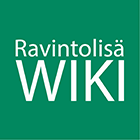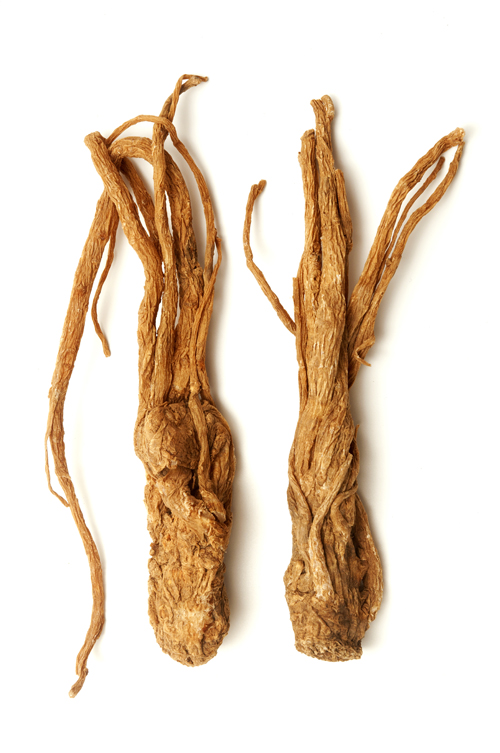Angelica sinensis
Yleistä tietoa
Angelica sinensis eli Kiinan karhunputki (Dong quai) on sarjakukkaisiin kuuluva monivuotinen kasvi, jonka juurta on käytetty perinteisessä kiinalaisessa lääketieteessä tuhansia vuosia kuukautiskipuihin, vaihdevuosioireiluun, nivelkipuihin, anemiaann, ummetukseen, allergioiden hoitoon ja vastustuskykyä vahvistamaan.Vaikuttavat aineet
Angelica sinensis sisältää haihtuvia öljyjä (safroli, isosafroli ja n-butyyliftalidiini), kumariinijohdannaisia, ferulahappoa, kasviestrogeeneja, polysakkarideja.
Ferulahapolla voi olla tärkeä rooli nivelrikon hoidossa vähentämällä interleukiinin ja tuumorinekroositekijän muodostumista. Se aktivoi myös rustoa muodostavien kondrosyyttien säätelyproteiinin (SOX9) geenin ilmentymistä. Kiinankarhunputkella on estrogeeniaktiivisuutta.
Vaikutus ja käyttö
Angelica sinensis uutteella on osoitettu kasvainten kasvua hillitsevä vaikutus (antitumoraalinen), tuberkuloosia vastaan taisteleva vaikutus, hermosoluja suojaava vaikutus ja ja verisolujen muodostusta aktivoiva vaikutus solukokeissa.
Kliinisissä vaihdevuosioiretutkimuksissa tehoa ei ole selkeästi osoitettu. Angelica sinensis on ennenaikasen siemensyöksyn hoitoon tarkoitetun voiteen yksi ainesosa.
Angelica sinensiksellä on saatu viitteita tehosta seuraavissa tiloissa, mutta tutkimusnäytön vähäisyyden suoksi tieteellistä arvioita ei voi vielä tehdä:
- Kivuliaat kuukautiset (dysmenorrhea).
- Kuukautisia edeltävä oireyhtymä (PMS).
- Korkea verenpaine.
- Nivelkivut.
- Haavaumat.
- Kasvaimet.
- Anemia.
- Ummetus.
- Ihon värin muutokset ja psoriasis.
- Allergiat.
Käytössä huomioitavaa
Angelica sinensis on ehkä turvallista aikuisille kohtuullisina annoksina lyhytaikaisessa käytössä. Se voi herkistää ihoa auringon valolle. Angelica sinensis saattaa olla vaarallista sikiölle raskauden aikana. Käytön turvallisuudesta raskauden ja imetyksen aikana ei ole riittävästi tietoa, joten siksi sitä raskauden ja imetyksen aikana suositellaan vältettävän.
Hormoni-herkkiä sairauksia, kuten rintasyöpä, kohtusyöpä, munasarjasyöpä tai endometrioosi sairastavien, tulee välttää Angelica sinensiksen käyttöä sen estrogeenivaikutusten vuoksi.
Proteiini S:n puutos: Ihmiset, joilla on proteiini S:n puutos on kohonnut riski verihyytymien kehittymiselle. Angelica sinensis saattaa lisätä riskiä hyytymän muodostumiseen näillä ihmisillä estrogeenivaikutustensa vuoksi.
Leikkaus: Angelica sinensis voi hidastaa veren hyytymistä ja käyttö tulee lopettaa 2 viikkoa ennen suunniteltua kirurgista toimenpidettä.
Angelica sinensis hidastaa veren hyytymistä eikä sitä pidä käyttä yhtä aikaa hyytymistä hidastavien lääkkeiden kanssa.
Lisätietoa
Tieteellisten artikkelien lyhennelmiä voi lukea PubMed:ssa http://www.ncbi.nlm.nih.gov/pubmed
Lähteet
- Al-Bareeq RJ, Ray AA, Nott L, Pautler SE, Razvi H. Dong Quai (angelica sinensis) in the treatment of hot flashes for men on androgen deprivation therapy: results of a randomized double-blind placebo controlled trial. Can Urol Assoc J. 2010 Feb;4(1):49-53.
- Amato P, Christophe S, Mellon PL. Estrogenic activity of herbs commonly used as remedies for menopausal symptoms. Menopause 2002;9:145-50.
- Armstrong TS and Gilbert MR. Use of complementary and alternative medical therapy by patients with primary brain tumors. Curr Neurol.Neurosci.Rep. 2008;8(3):264-268.
- Bone K. Clinical Applications of Ayurvedic and Chinese Herbs. Queensland (Australia): Phytotherapy Press; 1997.
- Carroll DG.Nonhormonal therapies for hot flashes in menopause.Am Fam Physician.2006;73(3):457-464.
- Cheema D, Coomarasamy A, El-Toukhy T.Non-hormonal therapy of post-menopausal vasomotor symptoms: a structured evidence-based review. Arch Gynecol Obstet. 2007;276(5):463-469.
- Choi HK, Jung GW, Moon KH, et al. Clinical study of SS-Cream in patients with lifelong premature ejaculation. Urology 2000;55:257-61.
- Choy YM, Leung KN, Cho CS, et al. Immunopharmacological studies of low molecular weight polysaccharide from Angelica sinensis. Am J Chin Med 1994;22:137-45.
- Chuang CH, Doyle P, Wang JD, et al. Herbal medicines used during the first trimester and major congenital malformations: an analysis of data from a pregnancy cohort study. Drug Saf 2006;29:537-48.
- Deng S, Wang Y, Inui T, et al. Anti-TB polyynes from the roots of Angelica sinensis. Phytother Res
- Eagon PK, Elm MS, Hunter DS, et al. Medicinal herbs: modulation of estrogen action. Era of Hope Mtg, Dept Defense; Breast Cancer Res Prog, Atlanta, GA 2000;Jun 8-11.
- Friedman JA, Taylor SA, McDermott W, Alikhani P. Multifocal and recurrent subarachnoid hemorrhage due to an herbal supplement containing natural coumarins. Neurocrit Care.2007;7(1):76-80.
- Fugate SE, Church CO. Nonestrogen treatment modalities for vasomotor symptoms associated with menopause. Ann Pharmacother. 2004;38(9):1482-1499.
- Goh SY, Loh KC. Gynaecomastia and the herbal tonic “Dong Quai”. Singapore Med J.2001;42(3):115-116.
- Haimov-Kochman R, Brzezinski A, and Hochner-Celnikier D. Herbal remedies for menopausal symptoms: are we cautious enough? Eur J Contracept.Reprod.Health Care 2008;13(2):133-137.
- Haines CJ, Lam PM, Chung TK, et al. A randomized, double-blind, placebo-controlled study of the effect of a Chinese herbal medicine preparation (Dang Gui Buxue Tang) on menopausal symptoms in Hong Kong Chinese women. Climacteric 2008 Jun;11(3):244-51.
- Hirata JD, Swiersz LM, Zell B, et al. Does dong quai have estrogenic effects in postmenopausal women? A double-blind, placebo-controlled trial. Fertil Steril 1997;68:981-6.
- Jalili J, Askeroglu U, Alleyne B, et al. Herbal products that may contribute to hypertension. Plast.Reconstr.Surg. 2013;131(1):168-173.
- Kan WL, Cho CH, Rudd JA, et al. Study of the anti-proliferative effects and synergy of phthalides from Angelica sinensis on colon cancer cells. J Ethnopharmacol. 10-30-2008;120(1):36-43.
- Kelley KW and Carroll DG. Evaluating the evidence for over-the-counter alternatives for relief of hot flashes in menopausal women. J.Am.Pharm.Assoc.(2003.) 2010;50(5):e106-e115.
- Kupfersztain C, Rotem C, Fagot R, Kaplan B. The immediate effect of natural plant extract, Angelica sinensis and Matricaria chamomilla (Climex) for the treatment of hot flushes during menopause. A preliminary report. Clin Exp Obstet Gynecol. 2003;30(4):203-206.
- Lam HW, Lin HC, Lao SC, et al. The angiogenic effects of Angelica sinensis extract on HUVEC in vitro and zebrafish in vivo. J Cell Biochem. Jan 1 2008;103(1):195-211.
- Lau CBS, Ho TCY, Chan TWL, Kim SCF. Use of dong quai (Angelica sinensis) to treat peri- and postmenopausal symptoms in women with breast cancer: is it appropriate? Menopause 2005;12:734-40.
- Lee WH, Jin JS, Tsai WC, et al. Biological inhibitory effects of the Chinese herb danggui on brain astrocytoma. Pathobiology. 2006;73(3):141-148.
- Lin B. Polyphenols and neuroprotection against ischemia and neurodegeneration. Mini.Rev.Med.Chem. 2011;11(14):1222-1238.
- Liu J, Burdette JE, Xu H, et al. Evaluation of estrogenic activity of plant extracts for the potential treatment of menopausal symptoms. J Agric Food Chem 2001;49:2472-9.
- Lu GH, Chan K, Leung K, et al. Assay of free ferulic acid and total ferulic acid for quality assessment of Angelica sinensis. J Chromatogr A 2005;1068:209-19.
- Majewska I and Gendaszewska-Darmach E. Proangiogenic activity of plant extracts in accelerating wound healing - a new face of old phytomedicines. Acta Biochim.Pol. 2011;58(4):449-460.
- Mazaro-Costa R, Andersen ML, Hachul H, et al. Medicinal plants as alternative treatments for female sexual dysfunction: utopian vision or possible treatment in climacteric women? J.Sex Med. 2010;7(11):3695-3714.
- Monograph. Angelica sinensis (Dong quai). Altern Med Rev 2004;9:429-33.
- Mousa SA. Antithrombotic effects of naturally derived products on coagulation and platelet function. Methods Mol.Biol. 2010;663:229-240.
- Page RL II, Lawrence JD. Potentiation of warfarin by dong quai. Pharmacotherapy 1999;19:870-6.
- Rotem C, Kaplan B. Phyto-Female Complex for the relief of hot flushes, night sweats and quality of sleep: randomized, controlled, double-blind pilot study. Gynecol Endocrinol. 2007;23(2):117-122.
- Shang P, Qian AR, Yang TH, et al. Experimental study of anti-tumor effects of polysaccharides from Angelica sinensis. World J Gastroenterol. 2003;9(9):1963-1967.
- Shi M, Chang L, He G. [Stimulating action of Carthamus tinctorius L., Angelica sinensis (Oliv.) Diels and Leonurus sibiricus L. on the uterus]. Zhongguo Zhong Yao Za Zhi 1995;20:173-5, 192.
- TNAM Society. Treatment of menopause-associated vasomotor symptoms: position statement of The North American Menopause Society. Menopause. 2004;11(1):11-33.
- Tsai NM, Lin SZ, Lee CC, et al. The antitumor effects of Angelica sinensis on malignant brain tumors in vitro and in vivo. Clin Cancer Res. 2005;11(9):3475-3484.
- Tyler V. The Honest Herbal: A Sensible Guide to Herbs and Related Remedies. Philadelphia: George Stickley Company; 1982.
- Wang C, Wan Y, Luo X, et al. [Regulative mechanism of Chinese herbal medicine on cell signaling pathway in kidney]. Zhongguo Zhong.Yao Za Zhi. 2011;36(1):85-91.
- Wong VC, Lim CE, Luo X, et al. Current alternative and complementary therapies used in menopause. Gynecol.Endocrinol. 2009;25(3):166-174.
- Xin YF, Zhou GL, Shen M, et al. Angelica sinensis: a novel adjunct to prevent doxorubicin-induced chronic cardiotoxicity. Basic Clin Pharmacol Toxicol. Dec 2007;101(6):421-426.
- Xu RS, Zong XH, and Li XG. [Controlled clinical trials of therapeutic effects of Chinese herbs promoting blood circulation and removing blood stasis on the treatment of reflex sympathetic dystrophy with type of stagnation of vital energy and blood stasis]. Zhongguo Gu.Shang 2009;22(12):920-922.
- Yim TK, Wu WK, Pak WF, et al. Myocardial protection against ischaemia-reperfusion injury by a Polygonum multiflorum extract supplemented 'Dang-Gui decoction for enriching blood', a compound formulation, ex vivo. Phytother Res 2000;14:195-9.
- Zhao H, Alexeev A, Sharma V, Guzman LD, Bojanowski K. Effect of SBD.4A—a defined multicomponent preparation of Angelica sinensis—in periodontal regeneration models. Phytother Res. Jul 2008;22(7):923-928.
- Zhao KJ, Dong TT, Tu PF, et al. Molecular genetic and chemical assessment of radix Angelica (Danggui) in China. J Agric Food Chem 2003;51:2576-83.
- Zhu DP. Dong Quai. Am J Chin Med 1987;15:117-25.
- Zhuang SR, Chiu HF, Chen SL, et al. Effects of a Chinese medical herbs complex on cellular immunity and toxicity-related conditions of breast cancer patients. Br.J.Nutr. 2012;107(5):712-718.
- Zuo AH, Wang L, and Xiao HB. [Research progress studies on pharmacology and pharmacokinetics of ligustilide]. Zhongguo Zhong.Yao Za Zhi. 2012;37(22):3350-3353.

